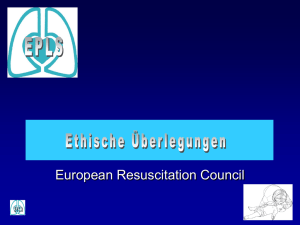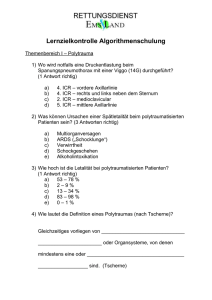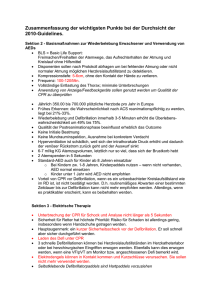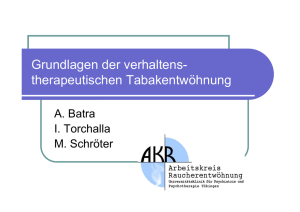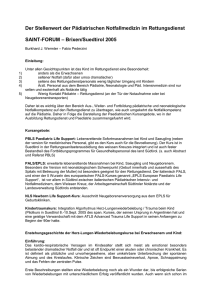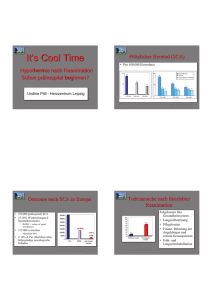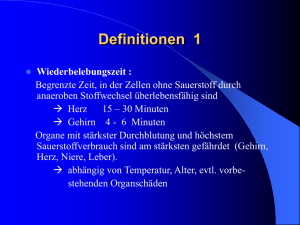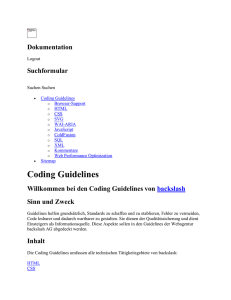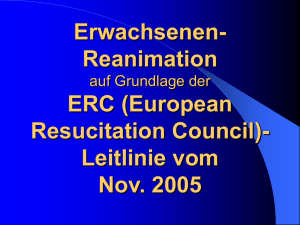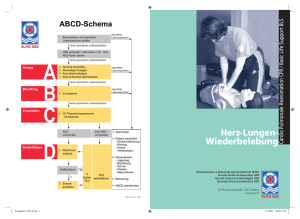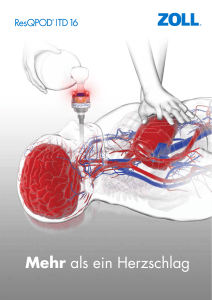Resuscitation 2005
Werbung
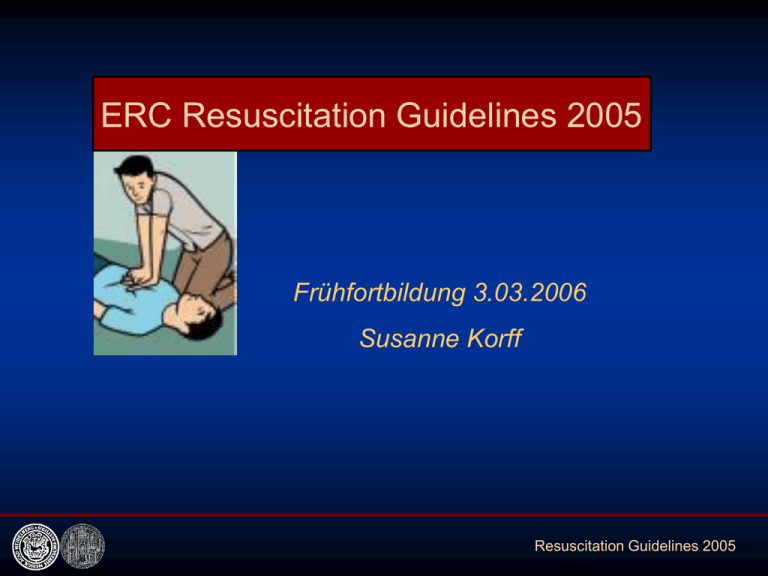
ERC Resuscitation Guidelines 2005 Frühfortbildung 3.03.2006 Susanne Korff Resuscitation Guidelines 2005 Background - Guidelines basierend auf Empfehlungen der ILCOR (International Liaison Committee on Resuscitation) - 1/2005 ILCOR Konferenz in Dallas mit 380 Experten aus 18 Ländern - Sudden cardiac death (SCD): 700.000 Einwohner/Jahr in Europa - Kammerflimmern (VF) = 40 % der SCD puplished in: Resuscitation 2005; Dec; 67: S3-S189 (Sections 1-9) Resuscitation Guidelines 2005 6 kontroverse Themen 1. CPR vor 1. Defibrillation bei VF ? 2. Verhältnis von Kompression : Ventilation ? 3. 1 x vs. 3 x Schock bei VF ? 4. Wahl der Energie bei der Defib. ? 5. Vasopressoren bei der CPR ? 6. Postreanimationsphase (Hypothermie) ? Resuscitation Guidelines 2005 Basic Life Support (BLS)- grundlegende Prinzipien 1. CPR vor 1. Defib. bei VF ? Vorteile: verdoppelt oder verdreifacht Überlebensrate bei VF, erhöht Erfolgswahrscheinlichkeit für Defib. 1. prähospital - unbezeugt + prof. Team: 2 min CPR vor Defib. - bezeugt durch prof. Team: sofortige Defib. 2. intrahospital - sofortige Defib. - "Early Defib." innerhalb von 3-5 min nach cardiac arrest: Überlebensrate: 49-75 %, jede Minute später → 10-15 %↓ Resuscitation. 2005; Dec; 67 Suppl 1: S7-23. Resuscitation Guidelines 2005 Basic Life Support (BLS)- grundlegende Prinzipien 2. Verhältnis Kompression : Ventilation ? - "compression-only" CPR ist gleich effektiv wie komb. "ventilation/compression" CPR in den ersten Minuten - 30 : 2 bei Erw. + Kinder (Ausnahme: Neugeborene) - Beginn mit 30 Kompressionen (Ausnahme: asphyktischer Kreislaufstilltand: Beginn mit Beatmung) - Druckpunkt = Zentrum der Brust !! - Sternum 4-5 cm eindrücken, Frequenz: 100/min Resuscitation Guidelines 2005 BLS - grundlegende Prinzipien - CPR auch nach Wiedererlangung von SR, da Kontraktion häufig noch ineffektiv - niedrigere Vt (6-7 ml/kg KG) und AF (10/min) Cave: hohe Vt → Magenüberblähung mit Aspiration !! Cave: Hyperventilation → intrathorak. p ↑, venöser Rückstrom↓, HZV ↓ ! - bei beatmeten Patienten: PEEP ausschalten Resuscitation. 2005; Dec; 67 Suppl 1: S7-23. Resuscitation Guidelines 2005 BLS - Use of external defibrillators 3. 1 x vs. 3 x Schock bei VF ? - single-shock strategy = nach 1. Shock sofort CPR ohne Pulskontrolle (2 min) 4. Wahl der Energie bei der Defib. ? - biphasische Geräte: first-shock efficacy = 86 - 98 % vs. 54 77 % bei monophasischen Geräten - biphasisch: initial shock energy: 150 J - 200 J monophasisch: immer 360 J !! Resuscitation. 2005; Dec; 67 Suppl 1: S 25-32. Resuscitation Guidelines 2005 BLS - Use of external defibrillators Elektrodenposition - sternal/axillär: rechts parasternal/mittlere Axillarlinie (= V6) - bei ♀ nicht über der Brust - alternativ: anterior/posterior, biaxillary - wenn möglich endexsp. defibrillieren, Defipaddles fest andrücken (8kg), Bevorzugung von self-adhesive pads Cave: Defib. in Sauerstoffatmosphäre ! → Sauerstoffmasken in 1 m Abstand legen, Ambubeutel oder Beatmungsgerät an Tubus etc. konnektiert lassen! Resuscitation. 2005; Dec; 67 Suppl 1: S 25-32. Resuscitation Guidelines 2005 Advanced Life Support (ALS) 5. Vasopressoren bei der CPR ? Adrenalin: keine Daten bzgl. Überlebensvorteil, dennoch Empfehlung, da 1. myokardialer und zerebraler Perfusionsdruck ↑ 2. Frequenzerhöhung von VF → Defib.erfolg ↑ 6. Antiarrhythmika bei der CPR ? Amiodaron > Lidocain (300 mg Amiodaron als Bolus, ggf. + 150 mg Bolus + 900 mg /24 h) Resuscitation. 2005; Dec; 67 Suppl 1: S 39-86. Resuscitation Guidelines 2005 Amiodaron vs. Lidocain bei VF Survival to Admission (%) Krankenhausentlassung: 45 40 Amiodaron: 9 / 180 = 5 % Lidocain: 5 / 167 = 3 % p = 0,34, nicht signifikant 35 Amiodaron (n = 180) 30 Lidocain (n = 147) 25 43 20 15 10 5 27 25 23 14 14 20 16 11 3 0 All Patients Initial Rhythm Initial Rhythm VF Asystole or PEA ROSC No ROSC Dorian P et al., N Engl J Med 346: 884-890, 2002 Resuscitation Guidelines 2005 Advanced Life Support (ALS) - shockable rhythms Reversible Ursachen evaluieren: VF / Pulsless VT 4 "H" s und 4 "T" s - Hypoxie 1. Schock (150-200 J biphasisch) CPR 30:2, 2 min 2. Schock (150-200 J biphasisch) CPR 30:2, 2 min - Hypovolämie - Hypo/Hyperkaliämie - Hypothermie - Tension Pneumothorax - Tamponade, Herz- Toxine - Thrombose (coronary, pulmonary) 1 mg Adrenalin i.v. 3. Schock (150-200 J biphasisch) 4. Schock (150-200 J biphasisch) CPR 30:2, 2 min 300 mg Cordarex CPR 30:2, 2 min 1 mg Adrenalin alle 3-5 min i.v. oder 3 mg i.t. ggf. erneut 150 mg Cordarex, Elektrodenposition verändern, 2 g (8 mmol) MgCl2, ggf. 50 mmol Nabic, Reanimation, Resuscitation. 2005; Dec; 67 Suppl 1: S 39-86. solange VF !!! Resuscitation Guidelines 2005 ALS - non-shockable rhythms (PEA, Asystolie) PEA / Asystolie CPR 30:2, 2 min + Adrenalin 1 mg 3 mg Atropin Adrenalin alle 3-5 min CPR 30:2, 2 min presence of p waves → pacemaker CPR 30:2, 2 min ggf. Aminophyllin 250-500 mg (5 mg/kg KG), 10 ml 10 % CaCl2 bei PEA im Rahmen von Hyperkaliämie und Hypokalzämie Resuscitation Guidelines 2005 Zusätzliche Therapie - Thrombolyse während CPR bei V.a. myokardiale Ischämie oder Lungenembolie - bei V.a. Hypovolämie NaCL Infusionen (kein Vorteil von Kolloiden, kein Routine-fluid Gabe) Postreanimationsphase: - therapeutische Hypothermie - Ziel-BZ: 80-110 mg/dl - Vermeidung von Temp. > 37 °C Resuscitation Guidelines 2005 Postreanimationsphase- milde Hypothermie Komatöse Patienten: 32 – 34 °C für 24 h nach ROSC Kontrolle (n = 137) Hypothermie (n= 136) „ gutes“ neurologisches Outcome (CPC: 1-2) 39 % 55 % * Mortalität nach 6 Monaten 55 % 41 % * CPC = cerebral performance category, 1 = good recovery, 2 = moderate disability * p < 0,05 The HACA Study Group, N Engl J Med 346 (8): 549-556, 2002 Resuscitation Guidelines 2005 What is new ? - mehr Thoraxkompressionen (30:2) anstatt 15:2 (für Erw. und Kinder, Ausnahme: Neugeborene) - Thoraxkompressionen dürfen nicht unterbrochen werden (single-shock Strategie) - Bevorzugung der Defib. mit biphasischer Wellenform - therapeutische Hypothermie für 12 - 24 h - Amiodaron als bevorzugtes AAR Resuscitation Guidelines 2005
